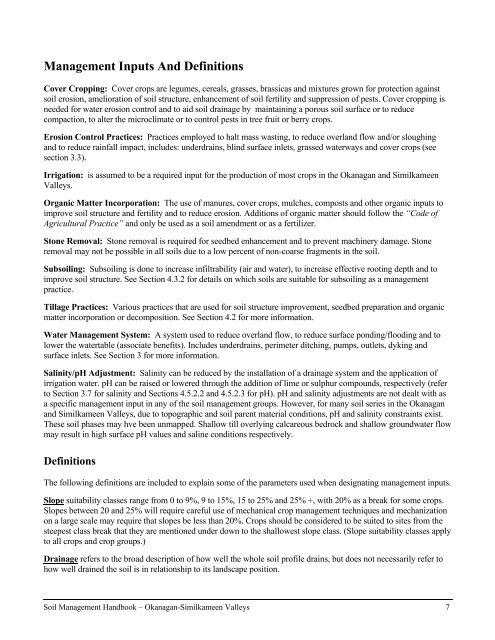Soil Management Handbook - Ministry of Agriculture and Lands
Soil Management Handbook - Ministry of Agriculture and Lands
Soil Management Handbook - Ministry of Agriculture and Lands
You also want an ePaper? Increase the reach of your titles
YUMPU automatically turns print PDFs into web optimized ePapers that Google loves.
<strong>Management</strong> Inputs And Definitions<br />
Cover Cropping: Cover crops are legumes, cereals, grasses, brassicas <strong>and</strong> mixtures grown for protection against<br />
soil erosion, amelioration <strong>of</strong> soil structure, enhancement <strong>of</strong> soil fertility <strong>and</strong> suppression <strong>of</strong> pests. Cover cropping is<br />
needed for water erosion control <strong>and</strong> to aid soil drainage by maintaining a porous soil surface or to reduce<br />
compaction, to alter the microclimate or to control pests in tree fruit or berry crops.<br />
Erosion Control Practices: Practices employed to halt mass wasting, to reduce overl<strong>and</strong> flow <strong>and</strong>/or sloughing<br />
<strong>and</strong> to reduce rainfall impact, includes: underdrains, blind surface inlets, grassed waterways <strong>and</strong> cover crops (see<br />
section 3.3).<br />
Irrigation: is assumed to be a required input for the production <strong>of</strong> most crops in the Okanagan <strong>and</strong> Similkameen<br />
Valleys.<br />
Organic Matter Incorporation: The use <strong>of</strong> manures, cover crops, mulches, composts <strong>and</strong> other organic inputs to<br />
improve soil structure <strong>and</strong> fertility <strong>and</strong> to reduce erosion. Additions <strong>of</strong> organic matter should follow the “Code <strong>of</strong><br />
Agricultural Practice” <strong>and</strong> only be used as a soil amendment or as a fertilizer.<br />
Stone Removal: Stone removal is required for seedbed enhancement <strong>and</strong> to prevent machinery damage. Stone<br />
removal may not be possible in all soils due to a low percent <strong>of</strong> non-coarse fragments in the soil.<br />
Subsoiling: Subsoiling is done to increase infiltrability (air <strong>and</strong> water), to increase effective rooting depth <strong>and</strong> to<br />
improve soil structure. See Section 4.3.2 for details on which soils are suitable for subsoiling as a management<br />
practice.<br />
Tillage Practices: Various practices that are used for soil structure improvement, seedbed preparation <strong>and</strong> organic<br />
matter incorporation or decomposition. See Section 4.2 for more information.<br />
Water <strong>Management</strong> System: A system used to reduce overl<strong>and</strong> flow, to reduce surface ponding/flooding <strong>and</strong> to<br />
lower the watertable (associate benefits). Includes underdrains, perimeter ditching, pumps, outlets, dyking <strong>and</strong><br />
surface inlets. See Section 3 for more information.<br />
Salinity/pH Adjustment: Salinity can be reduced by the installation <strong>of</strong> a drainage system <strong>and</strong> the application <strong>of</strong><br />
irrigation water. pH can be raised or lowered through the addition <strong>of</strong> lime or sulphur compounds, respectively (refer<br />
to Section 3.7 for salinity <strong>and</strong> Sections 4.5.2.2 <strong>and</strong> 4.5.2.3 for pH). pH <strong>and</strong> salinity adjustments are not dealt with as<br />
a specific management input in any <strong>of</strong> the soil management groups. However, for many soil series in the Okanagan<br />
<strong>and</strong> Similkameen Valleys, due to topographic <strong>and</strong> soil parent material conditions, pH <strong>and</strong> salinity constraints exist.<br />
These soil phases may hve been unmapped. Shallow till overlying calcareous bedrock <strong>and</strong> shallow groundwater flow<br />
may result in high surface pH values <strong>and</strong> saline conditions respectively.<br />
Definitions<br />
The following definitions are included to explain some <strong>of</strong> the parameters used when designating management inputs.<br />
Slope suitability classes range from 0 to 9%, 9 to 15%, 15 to 25% <strong>and</strong> 25% +, with 20% as a break for some crops.<br />
Slopes between 20 <strong>and</strong> 25% will require careful use <strong>of</strong> mechanical crop management techniques <strong>and</strong> mechanization<br />
on a large scale may require that slopes be less than 20%. Crops should be considered to be suited to sites from the<br />
steepest class break that they are mentioned under down to the shallowest slope class. (Slope suitability classes apply<br />
to all crops <strong>and</strong> crop groups.)<br />
Drainage refers to the broad description <strong>of</strong> how well the whole soil pr<strong>of</strong>ile drains, but does not necessarily refer to<br />
how well drained the soil is in relationship to its l<strong>and</strong>scape position.<br />
<strong>Soil</strong> <strong>Management</strong> <strong>H<strong>and</strong>book</strong> – Okanagan-Similkameen Valleys 7
















